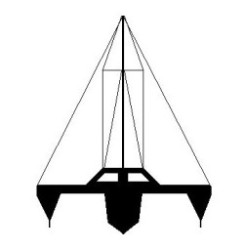Trimaran, Pivercraft Nimble
30' x 18' x 3 Tons
12-Ft. Dia. Sea Anchor
Force 5-6 Conditions
File S/T-36 obtained from John H. Baldwin, South Orleans, MA - Vessel name Goodspeed, hailing port South Orleans, trimaran designed by Arthur Piver, LOA 30' x Beam 18' x Draft 30" x 3 Tons - Sea anchor: 12-ft. Diameter Para-Tech on 400' x 1/2" nylon three strand tether and bridle arms of 45' each, with 1/2" galvanized swivel - Full trip line - Deployed in frontal trough in shallow water (20 fathoms) about 30 miles off Beaufort, North Carolina, with winds of 25 knots and seas of 6 ft. - Vessel's bow yawed 10° - Drift was 3 n.m. during 10 hours at sea anchor.
This file shows how a sea anchor can be used to "keep the sea" in terms of drift control. Groundings are among the fourteen major types of statistical accident data published in the Coast Guard's Boating Accident Reports. There are hundreds of groundings a year. Many a seaworthy yacht has survived the storm offshore only to run aground and be declared a total loss because of an error in navigation, or engine problems, or rudder problems. Quite often the needless loss occurs because of crew fatigue and impatience. The sight of the harbor range lights in the murky night is a temptation that sea-weary sailors would do well to resist, especially if it is a strange, windy harbor with a difficult, narrow entrance.
The scenario is all too familiar. The crew members have been cooped up in the heaving boat for days, maybe weeks. Likely exhausted, wet, cold, hungry and deprived of sleep, they can scarcely wait to set foot on dry ground, indulge in a steaming hot shower, inhale a couple of juicy hamburgers and climb into a comfortable, dry bed. So they decide to try to risk it - and run aground. Vessels equipped with sea anchors are better able to resist this temptation, since they can use the parachute to stand off until daylight. Instead of risking entry on a windy night, or trying to anchor the boat over a coral bottom with surf booming a hundred feet away, one can stand off a mile or two and use the parachute as an "offshore anchor," which is what your author used to do in the windy channels of Hawaii.
Goodspeed is an original Piver Nimble trimaran, used as a commercial fishing vessel by John Baldwin. Baldwin is offshore for long periods of time and often heaves to the parachute for sea layovers. He also uses it to stand off outside strange harbors, waiting for daylight. Transcript:
We deployed the sea anchor on the fourth day out.... There was no storm or nautical emergency. My crew mate Chris and I had been on a spinnaker run in the Gulf Stream, heading for Beaufort, North Carolina. Dusk found us still 30 miles from Beaufort with a freshening breeze from the south. Six months earlier we had learned a hard lesson: don't attempt to enter unfamiliar harbors at night. Tired and half seasick, we were approaching St. Mary's Inlet on the Georgia/Florida border. It was 4 am and we had been sailing all night on the working jib with the wind increasing from the north. "If I can find a light I'm going for it," I told Chris. I didn't have a large-scale chart and was nervous. Chris found the Waterway Guide and on the last page read "the stone jetties of the entrance are awash at half-tide, constituting a hazard." A quick check with the tide charts in Eldrige and sure enough, it was nearing half tide. We spent a hard couple of hours jibing and standing off, until dawn brought us in with the fishing boats.
Now, six months later, armed with our new parachute sea anchor, we doused the spinnaker, then hove-to the sea anchor with no trouble. Fishermen off the Pacific coast routinely deploy sea anchors at night. They know, and I know too, that nothing beats a sea anchor for peace of mind and a good night's sleep.
When using his sea anchor for station keeping offshore, John Baldwin has a unique way of obtaining the bridling advantage, without actually using a dedicated bridle (see image below). He gives the main tether (A) a few turns around the starboard float cleat, before securing it to big anchoring cleat on the main hull. He then brings a single, short utility line (B) from the port float and bends it onto the main rode by means of a rolling hitch. This way, even if the rolling hitch slips - he says it never has - throwing the turns off the starboard float will put the main rode back on the center hull. Of course, the purpose of this arrangement is to allow variable rode lengths for multihulls, in non-storm applications.

